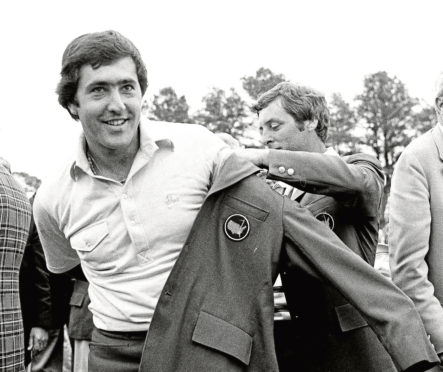It’s Masters week, and we’re all going to miss it acutely. No matter how much of an Augusta agnostic you are – guilty as charged – it’s sneakily beguiling enough to drag you into its embrace.
I’d always have the burned July fairways of a Birkdale in 1976, Turnberry in 1977 – guess when I started loving golf – or Carnoustie in 2018 than the impossible greenness of every Augusta April.
But it’s hopeless to resist. It’s the start of golf in every year for almost everyone. No matter how fake it appears, no matter if the birdsong is piped in, it’s golf’s annual emergence from winter.
Not this year, thanks to the coronavirus. We may get a Masters in the orange colours of the autumn, which might make me love it unconditionally at last. But this particular week marks one special reason for European fans to remember Augusta especially fondly.
Forty years ago this week, it’s where Seve Ballesteros changed everything.
You can watch it right now. One thing Augusta does unequivocally well is the internet, from the “every shot by anybody” innovation they introduced for their website a couple of years ago to having every final day’s CBS broadcast on YouTube for anyone to watch, completely free of charge. No Sky subscription required.
Except the 1980 version is curious. Half of it is without commentary – did CBS take a pass that year? There were few recognisable Americans near the top of the leaderboard. But for Gary Player and a fleeting, almost tragic effort by the great Roberto de Vicenzo of Argentina in 1968, Augusta was usually an America-first feast that even Donald Trump might think overdone.
Europeans didn’t even really get to play. Player won the Masters three times, and until 1980 he was the only “foreign” winner.
Player’s last Green Jacket, in 1978, came with a final round 64 playing with…guess who, in his second ever Masters. Seve, 21 on the final day of that event, finished T-18 and wasn’t in the hunt, yet was avid and vocal in his support of the South African.
As Player downed a birdie putt on the last which would eventually win his third Green Jacket, Seve leapt across the green to embrace the South African with unabashed joy. Why? The fans had been on Player’s back the whole way home, and Seve’s antipathy to the biased US galleries was already well established.
The antipathy seemed to be mutual. In the July before the 1980 Masters, Seve won the Open at Lytham, but was crowned “the car park champion” by the US golf media for one particularly wayward shot. The recovery birdie from that shot, at the 16th on the final day, confirmed his incredible genius to European golf fans of my generation, but to Americans it simply proclaimed him as lucky.
Augusta in 1980 should have ended that nonsense. He was ten ahead (ten!!!) at the turn on Sunday. He coasted home to win by four, with meaningless visits to Rae’s Creek on 12 and 13.
Thomas Boswell, of the Washington Post, was still unforgiving. “Respect for the Masters had faded”, he wrote. “The greens…began to lose their punch. It didn’t matter how wildly you hit the ball, as Seve Ballesteros did in 1980, you could always throw the ball up somewhere on the green and two putt…maybe make an undeserved birdie”.
As always, you had to look for Dan Jenkins, Augusta’s perennial writer-in-residence, for proper perspective.
“Never did he deserve to lose it, for he had simply lapped the field,” wrote Jenkins in Sports Illustrated. “When he went to the last nine holes on Sunday with a 10-shot lead on everybody, it raised the question of whether the American pros are spending too much time getting rich off their eighth-place finishes.
“Ballesteros is not only immensely talented, having both length and style, but he is also obviously hungry. Anyone can stumble into one major championship. It takes a rare ability of one kind or another to win two of them.”
As Boswell seemed to request, they changed the greens at Augusta from a mixture of rye and Bermuda grass to bentgrass in 1981, creating the fearsome, marble-ish surfaces we know today.
And then in 1983, it happened again. Seve humbled them all at Augusta, regardless of whatever grass they had on the greens, and won for a second time.
The following year he won the Open, in the most thrilling fashion at St Andrews, where he most wanted to win. And in 1985 Europe finally humbled the USA at last at the Ryder Cup, with Seve the unquestioned talisman.
He kicked down the door, and his peers Sandy Lyle, Nick Faldo, Bernhard Langer, Ian Woosnam and all the rest since – Olazabal, Harrington, Rose, McIlroy, Kaymer, Molinari, Lowry – poured through after him.
Seve never won a major after his 1988 Open triumph at Lytham, when he was just 31. He burned out early with injury and we lost him appalling early, to a brain tumour in 2011 at just 54.
But nothing can dim his brilliance in my eye, and that of every other European golf fan of my generation.
Seve’s there whenever a European wins a major anywhere, whenever Europe win another Ryder Cup anywhere. Because he started it all.
